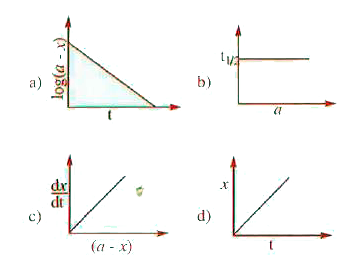What will be the nature of the graph showing the concentration of the reactant and time of a first order reaction ? Solution in Bengali
Step by step video & image solution for What will be the nature of the graph showing the concentration of the reactant and time of a first order reaction ? by Chemistry experts to help you in doubts & scoring excellent marks in Class 12 exams.
Updated on:21/07/2023Topper's Solved these Questions
- CHEMICAL KINETICSBook:CHHAYA PUBLICATIONChapter:CHEMICAL KINETICSExercise:QUESTION-ANSWER ZONE FOR BOARD EXAMINATION (VERY SHORT ANSWER TYPE)
Explore 35 Videos
- CHEMICAL KINETICSBook:CHHAYA PUBLICATIONChapter:CHEMICAL KINETICSExercise:SOLVED WBCHSE SCANNER (2014)
Explore 3 Videos
- CHEMICAL KINETICSBook:CHHAYA PUBLICATIONChapter:CHEMICAL KINETICSExercise:EXERCISE (NUMERICAL PROBLEMS)
Explore 37 Videos
- BIOMOLECULESBook:CHHAYA PUBLICATIONChapter:BIOMOLECULESExercise:Practic Set 29
Explore 1 Video
- CHEMICAL THERMODYNAMICSBook:CHHAYA PUBLICATIONChapter:CHEMICAL THERMODYNAMICSExercise:Practice Set 6
Explore 15 Videos
Similar Questions
For the reaction 12A2+32B2→AB3, express the rate in terms of decrease in concentration of the reactants and increase in concentration of the product.
View Solution50% of a first order reaction gets completed in 10 min. What fraction of reactant of the above reaction would remain after 20min ?
View Solution2A→4B+D , in this reaction, concentration of B increases to 2×10−3mol.L−1 after 10s from the start of the reaction . Calculate : rate of formation of B
View SolutionWrite down the structure of tripeptide Gly-Ala-Val.
View SolutionThe condition for spontaneity of process is
View SolutionAssertion: For a first order reaction, the concentration of the reactant decreases exponentially with time. Reason: Rate of reaction at any time depend upon the concentration of reactant at that time.
View SolutionDraw a schematic graph showing how the rate of first order reaction changes with change in concentration of reactants.
View SolutionDraw a schematic graph showing how the rate of a first order reaction changes with change in concentration of the reactant.
View SolutionAssertion. For a first order reaction, the concentration of the reactant decreases exponentially with time. Reason. Rate of reaction at any time depends upon the concentration of the reactant at that time.
View SolutionShow that the time of a first order reaction takes for 'the nth' fraction of the initial concentration of its reactant to converted into product does not depend on the initial concentration of the reactant.
View SolutionFor a zero order reaction, the initial concentration of the reactant =[A]0 and after time 't' from the initiation of the reaction, the concentration =[A] . What will be the nature of the graph of '[A]' vs 't,
View SolutionWhat is slope of the graph of log[A] vs t for a first order reaction, where [A] is the concentration of reactant at any time t during the reaction.
View SolutionPlot a graph of concentration of a reactant at time t, [ (a-x)] against time for a first order reaction .Here a = initial concentration of the reactant an x = change in concentration of the reactant at any time 1 during the reaction.
View SolutionFor a first order reaction, the concentration of reactant :
View SolutionWhich of the following graphs represent a first order reaction (a=initial concentration of reactant, x=concentration of reactant consumed, t=time)

View Solution